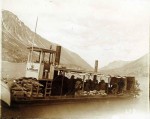 In July of 2008, researchers found the nearly intact shipwreck of the Gold Rush paddle steamboat A.J. Goddard sitting upright on the floor of Lake Laberge, in Yukon Territory, Canada, where it had sunk in October of 1901 killing all but two of the crew. The Goddard was a famous ship in its day for having been the first to reach Dawson City traveling down the Yukon River after the first winter of the Klondike Gold Rush in 1897. The two survivors had grabbed on to the pilot house that came off the top of the boat and were rescued by a nearby trapper.
In July of 2008, researchers found the nearly intact shipwreck of the Gold Rush paddle steamboat A.J. Goddard sitting upright on the floor of Lake Laberge, in Yukon Territory, Canada, where it had sunk in October of 1901 killing all but two of the crew. The Goddard was a famous ship in its day for having been the first to reach Dawson City traveling down the Yukon River after the first winter of the Klondike Gold Rush in 1897. The two survivors had grabbed on to the pilot house that came off the top of the boat and were rescued by a nearby trapper.
 Except for that missing pilot house, the rest of the Goddard was in excellent condition thanks to the very cold waters of Lake Laberge. The ship was immediately billed a “ghost ship” because of the time capsule-like preservation of the boat itself and its cargo. Even the belongings of the crew, like the boots of all five crewmen who presumably kicked them off when they abandoned ship, and everyday artifacts like axes and kitchen utensils were found where they fell.
Except for that missing pilot house, the rest of the Goddard was in excellent condition thanks to the very cold waters of Lake Laberge. The ship was immediately billed a “ghost ship” because of the time capsule-like preservation of the boat itself and its cargo. Even the belongings of the crew, like the boots of all five crewmen who presumably kicked them off when they abandoned ship, and everyday artifacts like axes and kitchen utensils were found where they fell.
Some of the more important ones were removed for conservation, among them a gramophone and three records, one of which was actually in the player and may have been jangling a happy minstrel tune when the boat went down. Researchers were able to conserve the records, repairing them enough that the titles were visible, although sadly they are still not playable.
[Texas A & M’s Nautical Archaeology Program graduate student Lindsey] Thomas said the three recordings, including Rendezvous Waltz and a rare 1896 minstrel recording of Ma Onliest One, were previously unknown to Gold Rush-era music experts.
“These are three new songs that we now know people were listening to during the Gold Rush, and they were playing it,” she said. “Ma Onliest One was the disc that was attached to the gramophone.”
Thomas said minstrel songs were popular at the time because they were “easy for the miners and for the people up there to perform.”
“It became popular in the 1820s, but they were able to put on shows and pass the time amongst themselves as they were stuck in cabins over the winter,” she said.
It was Conservator Tara Grant, from the Canadian Conservation Institute in Ottawa, who was able to retrieve the titles from the unplayable — one of them broken in two pieces — records. The third tune was “The Harp that Once thro’ Tara’s Halls” by Thomas Moore. The conservator for the territorial Department of Tourism and Culture, Valery Monahan, looked far and wide for copies of the songs, none of which were particularly popular pieces at the time. She tracked all three titles down in the Library of Congress, but only one of them was listenable online: “Rendez Vous Waltz” performed by the Metropolitan Orchestra.
Although the other two songs are in the Library of Congress’ collection, they can not be uploaded for our listening pleasure because, get this, they are under copyright by Sony Music. They’d probably sue the dead sailors for file sharing.
The records and gramophone will be returned to the Yukon for long-term preservation and display at the Yukon Transportation Museum. As items of exceptional value to Canadian history, they will be conserved free of charge.
Not only are Gold Rush shipwrecks exceptionally rare, intact ones are practically unheard of, but the records show a whole new side of life on the workhorse of the Klondike waterways. These steamboats were utilitarian vehicles. Cooking pots, work equipment, even the remarkably useful tool-repair shop found on board were all to be expected. Luxury, space-hogging items like a bulky gramophone and records to play, on the other hand, were surprising finds.